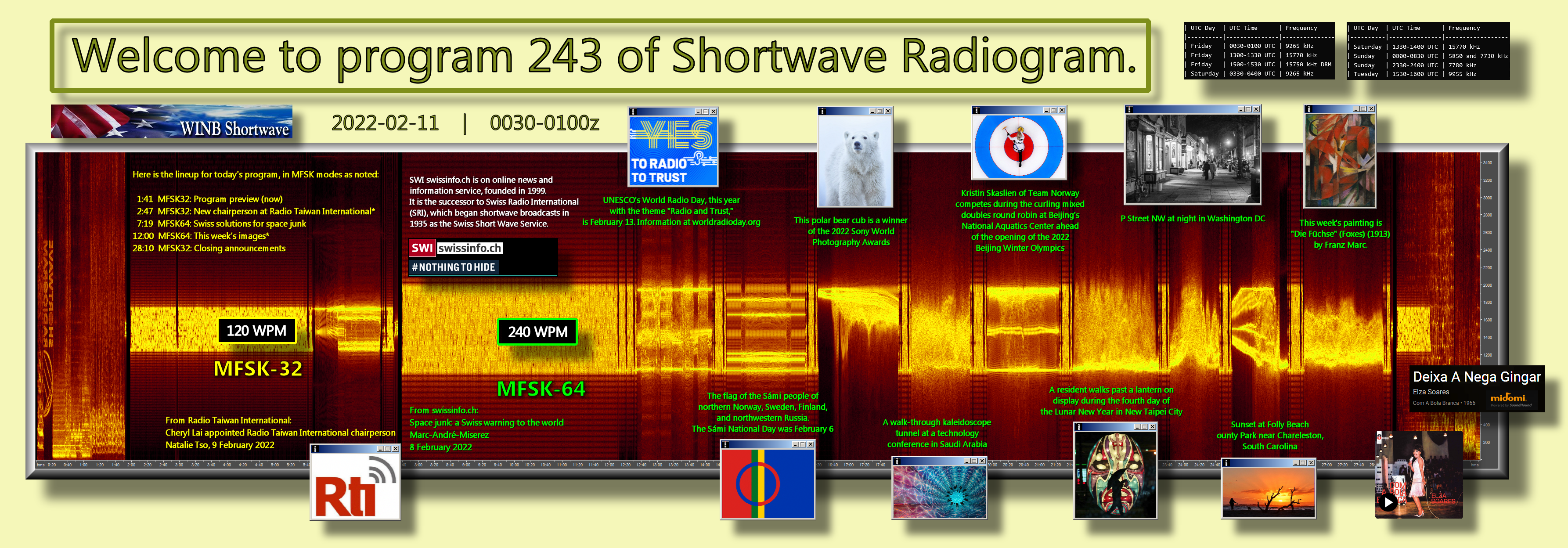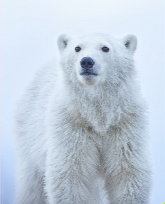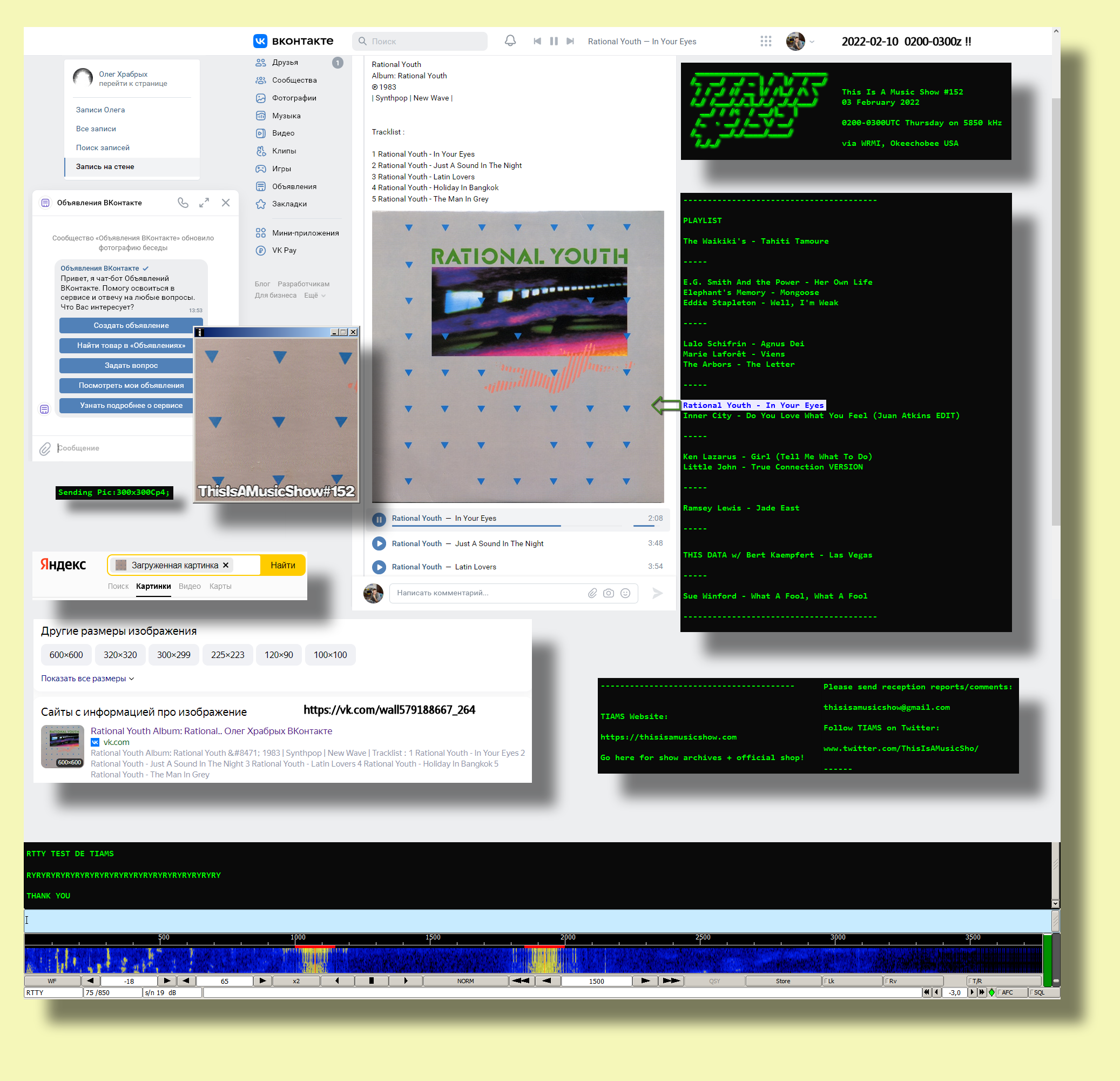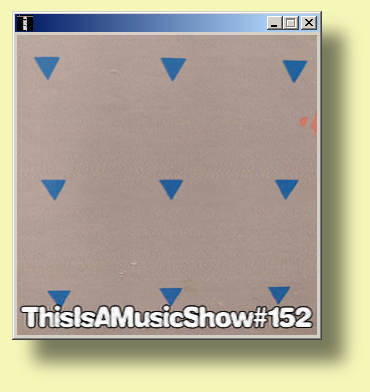http://www.rhci-online.net/radiogram/radiogram.htm

http://www.rhci-online.net/radiogram/radiogram.htm

RSID: <<2022-02-11T00:31Z MFSK-32 @ 9265000+1500>>
Welcome to program 243 of Shortwave
Radiogram.
I'm Kim Andrew Elliott in Arlington, Virginia USA.
Here is the lineup for today's program, in MFSK modes as noted:
1:41 MFSK32: Program preview (now)
2:47 MFSK32: New chairperson at Radio Taiwan International*
7:19 MFSK64: Swiss solutions for space junk
12:00 MFSK64: This week's images*
28:10 MFSK32: Closing announcements
* with image(s)
Please send reception reports to
radiogram@verizon.net
And visit http://swradiogram.net
We're on Twitter now: @SWRadiogram
|
|
https://de.rti.org.tw/news/view/id/2004981
Cheryl Lai zur Vorsitzenden von
Radio Taiwan International ernannt
https://de.rti.org.tw/radio/podcastList
|
Shortwave Radiogram now changes to MFSK64 ...
RSID: <<2022-02-11T00:37Z MFSK-64 @ 9265000+1500>>
This is Shortwave Radiogram in MFSK64
Please send your reception report to
radiogram@verizon.net
From swissinfo.ch:
Space junk: a Swiss warning to the world
Marc-André-Miserez
8 February 2022
On November 15 last year, some 480 kilometres above the vast
Russian steppes, the satellite Kosmos-1408 exploded in silence,
disintegrating into a cloud of debris of various sizes. Retired
from service 40 years ago, the spacecraft had just been hit by an
A-235 antiballistic missile, fired from the Plesetsk Cosmodrome.
Four hundred and eighty kilometres – that's dangerously close to
the orbit of the International Space Station (ISS). The seven
crew members were immediately told to put on their space suits
and take shelter in the emergency capsules which would bring them
back to Earth if there was a collision.
At the Pentagon, Russia's action was denounced as "reckless" and
"dangerous and irresponsible". Moscow responded that everything
had conformed with safety rules. After all, there are two Russian
cosmonauts on the ISS, one of whom is the commanding officer.
Collisions in space
This space shoot'em up was not the first of its kind. China in
2007, the US in 2008 and India in 2019 had already put on such a
show of force – always on one of their own satellites.
There have also been accidental collisions. On March 22, 2021,
the Chinese weather satellite Yunhai 1-02 struck a piece of a
Russian Zenit-2 rocket launched in the 1990s. That was the worst
orbital collision documented since 2009, when the Russian
military satellite Kosmos-2251 hit Iridium 33, an American
communications satellite.
Each of these incidents, whether intended or not, added several
hundred bits of debris to what is already present in the low
Earth orbit range (up to 2,000km altitude). There are already
34,000 pieces of space junk, counting only those that ground
radar systems can detect. There are also around 130 million small
bits of debris orbiting at 20 times the speed of a rifle bullet
which are also likely to cause considerable damage on impact.
Ideas for a solution
Today, space agencies and private-sector satellite launch
companies as well as the research world are very much aware of
the problem. Scientists at the Swiss Federal Institute of
Technology Lausanne (EPFL) have been working on it since at least
2012, when the ClearSpace project was initiated. This is a
project to develop the first satellite that can actually pick up
space junk.
However, decision-makers have not been convinced of the value of
investing in such waste management solutions. Marie-Valentine
Florin, director of EPFL's International Risk Governance Centre,
pointed out to Muriel Richard-Noca, co-founder of ClearSpace,
that there was no comparative study of the various solutions and
the costs involved.
This task went to Romain Buchs, a young physicist who had just
completed a Masters thesis studying the issue of waste management
in space. An initial report came out in spring 2021, and at the
end of November a set of options for political and industrial
decision-makers was added.
"We targeted this paper at about 400 people in the space agencies
and the private sector," Buchs says, conceding that "it is
difficult to reach the Chinese and the Russians" and that
military leaders are not on the list.
"Normally these satellites are supposed to re-enter the
atmosphere [and burn up] 25 years after their operating cycle is
completed, at the latest. But the rule is not binding and it's
often ignored. About 60% of satellites follow the rule, though it
should be at least 90%," he says.
Small and large fry in orbit
Meanwhile, more and more satellites are out there. And for
several years states have no longer had a monopoly on access to
space. The trend has been for low-orbit satellite constellations.
This began at the end of the 20th century with Iridium and
Globalstar for satellite telephone communications. But there were
barely 100 of these.
Following OneWeb, then Starlink (SpaceX) and Kuiper (Amazon),
satellites were now in the thousands, supposed to bring fast
internet access to the whole world. The operators promised to
take all necessary precautions, keeping their spacecraft flying
low enough for them to fall out of orbit automatically after a
few years, or else fitting them with devices to facilitate their
capture by future space pick-up craft.
For Buchs, these clouds of small satellites are not really the
problem. "Basically, states have created the problem. The newer
satellite constellations are most likely to get hit. Those are
the little satellites, which weigh barely 150 kilos each. The
real problems come from whole rocket stages – above all Russian
ones – which may weigh up to nine tonnes each and which were
jettisoned between 1980 and 2005," he explains.
Getting a grip on the chaos
That said, Buchs doesn't believe in apocalyptic scenarios such as
the Kessler syndrome, which envisages near space becoming so
crowded that further flights would become impossible.
"We'll never be able to pick up all the small debris – we'll have
to concentrate on the big chunks, which may crash into one
another and shatter into thousands more little bits. There are
about 2,000 of them in low orbit. If we picked up just three or
four of them a year, it would reduce the risk considerably," he
says.
This is the goal of the ClearSpace project, which started at EPFL
and is now under the aegis of the European Space Agency. The
Japanese now have a similar project and there will be others.
Meanwhile, if anyone thinks it would be enough to declare a
moratorium on all new launches into orbit, they forget how much
our world depends on satellites.
"Just to take one example, 26 of the 55 parameters used for
measuring climate change can be calculated only from space,"
Buchs says.
(Translated from French by Terence MacNamee)
https://www.swissinfo.ch/eng/sci-tech/space-junk--a-swiss-warning-to-the-world-47320912
This is Shortwave Radiogram in MFSK64
Please send your reception report to
radiogram@verizon.net
This week's painting ...
UNESCO's World Radio Day, this year with the theme "Radio and
Trust," is February 13. Information at
worldradioday.org ...
Sending Pic:199x156C;

The flag of the Sámi people of northern Norway, Sweden, Finland,
and northwestern Russia. The Sámi National Day was February 6.
https://bit.ly/3gDDWZG ...
Sending Pic:210x156C;
This polar bear cub is a winner of the 2022 Sony World
Photography Awards.
https://bit.ly/3uBg5Cl ...
Sending Pic:165x204C;

A walk-through kaleidoscope tunnel at a technology conference in
Saudi Arabia.
https://bit.ly/3LhrEEu ...
Sending Pic:210x117C;

Kristin Skaslien of Team Norway competes during the curling mixed
doubles round robin at Beijing's National Aquatics Center ahead
of the opening of the 2022 Beijing Winter Olympics.
https://bit.ly/3JyPUR5 ...
Sending Pic:210x143C;

A resident walks past a lantern on display during the fourth day
of the Lunar New Year in New Taipei City.
https://bit.ly/3oCXRws
...
Sending Pic:184x195C;

P Street NW at night in Washington DC.
https://wapo.st/3uBYc6b
...
Sending Pic:305x202;

https://en.wikipedia.org/wiki/P_Street
Sunset at Folly Beach County Park near Chareleston, South
Carolina.
https://bit.ly/3BepIbu ...
Sending Pic:209x112C;

This week's painting is Die Füchse (Foxes) (1913) by Franz Marc.
It is expected to fetch around £35 million ($46.8 million) at a
Christie's auction in March.
https://bit.ly/364TFz6 ...
Sending Pic:158x211C;

Shortwave Radiogram returns to MFSK32 ...
RSID: <<2022-02-11T00:58Z MFSK-32 @ 9265000+1500>>
This is Shortwave Radiogram in MFSK32 ...
Shortwave Radiogram is transmitted
by:
WRMI, Radio Miami International, wrmi.net
and
WINB Shortwave, winb.com
Please send reception reports to
radiogram@verizon.net
And visit http://swradiogram.net
Twitter:
@SWRadiogram or twitter.com/swradiogram
I'm Kim Elliott. Please join us for the next Shortwave
Radiogram.
|
Closing music SWRG#243: https://www.midomi.com/Track?trackID=100345760329626501&song=deixa-a-nega-gingar-(sand%C3%A1lia-dela) https://en.wikipedia.org/wiki/Elza_Soares Elza da Conceição Soares (née Gomes; 23 June 1930 – 20 January 2022) (known professionally as Elza Soares)
|

http://www.rhci-online.net/radiogram/radiogram.htm
|
QTH: |
D-06193 Petersberg (Germany/Germania) |
|
|
Ant.: |
Dipol for 40m-Band & Boomerang Antenna 11m-Band |
|
|
RX for RF: |
FRG-100B + IF-mixer & ICOM IC-R75 + IF-mixer |
|
|
Software IF: |
con STUDIO1 - Software italiano per SDR [S-AM-USB/LSB] + beta 11 Version 2.80 (August 21, 2018) - for scheduled IF-recording |
|
|
Software AF: |
Fldigi-4.0.18 + flmsg-4.0.7 images-fldigifiles on homedrive.lnk |
|
|
OS: |
German XP-SP3 with support for asian languages |
German W7 32bit + 64bit |
|
PC: |
MEDION Titanium 8008 (since 2003) [ P4 - 2,6 GHz] |
MSI-CR70-2MP345W7 (since2014) [i5 -P3560 ( 2 x 2,6GHz) ] |
http://wiki.radioreference.com/index.php/Decoding_the_SW_Radiogram_Broadcasts
https://www.qsl.net/ve7vv/Files/Digital%20Modes.pdf
RSID: <<2022-02-13T01:30Z
MFSK-64 @
5960000+1500>>
Sérgio Mendes of Brasil '66 etc was
born born February 11, 1941.
Sending Pic:175x257;

sergiomendesmusic.com
Please report your decode to
themightykbc@gamil.com

RSID: <<2022-02-10T02:47Z MFSK-64 @ 5850000+1500>>
This Is A Music Show #152
03 February 2022
0200-0300UTC Thursday on 5850 kHz
via WRMI, Okeechobee USA
***ALSO***
TIAnExpressMS w/ Radio Northern Europe International
via Channel 292 in Germany, mainly on 6070 kHz.
Broadcast various dates/times/freqs. Check the schedule here:
https://www.channel292.de/
https://rnei.org/
----------------------------------------
PLAYLIST
The Waikiki's - Tahiti Tamoure
-----
E.G. Smith And the Power - Her Own Life
Elephant's Memory - Mongoose
Eddie Stapleton - Well, I'm Weak
-----
Lalo Schifrin - Agnus Dei
Marie Laforêt - Viens
The Arbors - The Letter
-----
Rational Youth - In Your Eyes
Inner City - Do You Love What You Feel (Juan Atkins EDIT)
-----
Ken Lazarus - Girl (Tell Me What To Do)
Little John - True Connection VERSION
-----
Ramsey Lewis - Jade East
-----
THIS DATA w/ Bert Kaempfert - Las Vegas
-----
Sue Winford - What A Fool, What A Fool
----------------------------------------
TIAMS Website:
https://thisisamusicshow.com
Go here for show archives + official shop!
-----
Please send reception reports/comments:
thisisamusicshow@gmail.com
Follow TIAMS on Twitter:
www.twitter.com/ThisIsAMusicSho/
------
Thanks for listening!
--YOUR HOST--
EOM
RSID: <<2022-02-10T02:48Z
MFSK-64 @
5850000+1500>>
Sending Pic:300x300Cp4;

https://vk.com/wall579188667_264
https://www.dropbox.com/s/hgs5yab7d9qyerb/2022-02-03_SWRGRNEI-00_StudioUno.png?dl=0
http://www.rhci-online.net/html/SWRGRNEI-00/SWRGRNEI-00-00.html
http://www.rhci-online.net/html/RNEI26.html